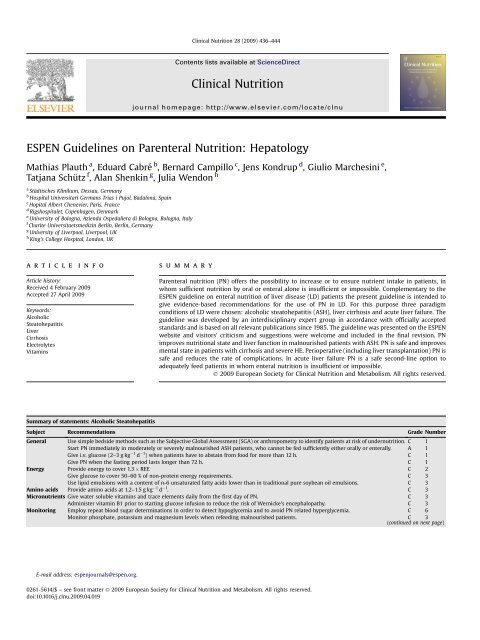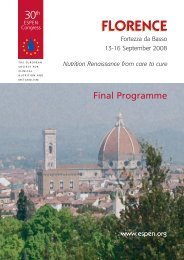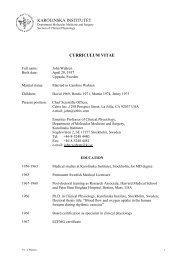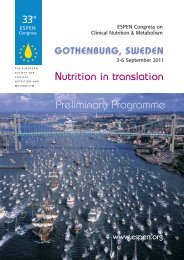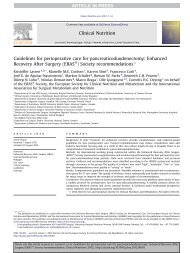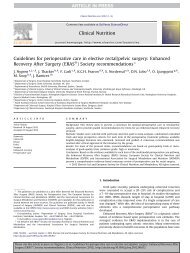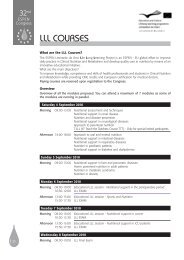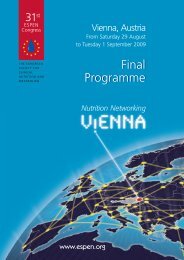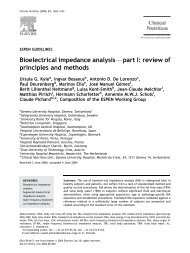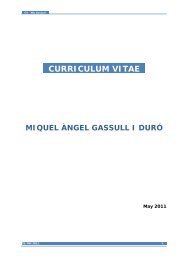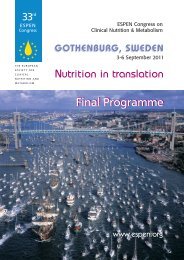ESPEN Guidelines on Parenteral Nutrition: Hepatology
ESPEN Guidelines on Parenteral Nutrition: Hepatology
ESPEN Guidelines on Parenteral Nutrition: Hepatology
You also want an ePaper? Increase the reach of your titles
YUMPU automatically turns print PDFs into web optimized ePapers that Google loves.
<str<strong>on</strong>g>ESPEN</str<strong>on</strong>g> <str<strong>on</strong>g>Guidelines</str<strong>on</strong>g> <strong>on</strong> <strong>Parenteral</strong> Nutriti<strong>on</strong>: <strong>Hepatology</strong><br />
Mathias Plauth a , Eduard Cabré b , Bernard Campillo c , Jens K<strong>on</strong>drup d , Giulio Marchesini e ,<br />
Tatjana Schütz f , Alan Shenkin g , Julia Wend<strong>on</strong> h<br />
a<br />
Städtisches Klinikum, Dessau, Germany<br />
b<br />
Hospital Universitari Germans Trias i Pujol, Badal<strong>on</strong>a, Spain<br />
c<br />
Hopital Albert Chenevier, Paris, France<br />
d<br />
Rigshospitalet, Copenhagen, Denmark<br />
e<br />
University of Bologna, Azienda Ospedaliera di Bologna, Bologna, Italy<br />
f<br />
Charite Universitaetsmedizin Berlin, Berlin, Germany<br />
g University of Liverpool, Liverpool, UK<br />
h King’s College Hospital, L<strong>on</strong>d<strong>on</strong>, UK<br />
article info<br />
Article history:<br />
Received 4 February 2009<br />
Accepted 27 April 2009<br />
Keywords:<br />
Alcoholic<br />
Steatohepatitis<br />
Liver<br />
Cirrhosis<br />
Electrolytes<br />
Vitamins<br />
summary<br />
<strong>Parenteral</strong> nutriti<strong>on</strong> (PN) offers the possibility to increase or to ensure nutrient intake in patients, in<br />
whom sufficient nutriti<strong>on</strong> by oral or enteral al<strong>on</strong>e is insufficient or impossible. Complementary to the<br />
<str<strong>on</strong>g>ESPEN</str<strong>on</strong>g> guideline <strong>on</strong> enteral nutriti<strong>on</strong> of liver disease (LD) patients the present guideline is intended to<br />
give evidence-based recommendati<strong>on</strong>s for the use of PN in LD. For this purpose three paradigm<br />
c<strong>on</strong>diti<strong>on</strong>s of LD were chosen: alcoholic steatohepatitis (ASH), liver cirrhosis and acute liver failure. The<br />
guideline was developed by an interdisciplinary expert group in accordance with officially accepted<br />
standards and is based <strong>on</strong> all relevant publicati<strong>on</strong>s since 1985. The guideline was presented <strong>on</strong> the <str<strong>on</strong>g>ESPEN</str<strong>on</strong>g><br />
website and visitors’ criticism and suggesti<strong>on</strong>s were welcome and included in the final revisi<strong>on</strong>. PN<br />
improves nutriti<strong>on</strong>al state and liver functi<strong>on</strong> in malnourished patients with ASH. PN is safe and improves<br />
mental state in patients with cirrhosis and severe HE. Perioperative (including liver transplantati<strong>on</strong>) PN is<br />
safe and reduces the rate of complicati<strong>on</strong>s. In acute liver failure PN is a safe sec<strong>on</strong>d-line opti<strong>on</strong> to<br />
adequately feed patients in whom enteral nutriti<strong>on</strong> is insufficient or impossible.<br />
Ó 2009 European Society for Clinical Nutriti<strong>on</strong> and Metabolism. All rights reserved.<br />
Summary of statements: Alcoholic Steatohepatitis<br />
Subject Recommendati<strong>on</strong>s Grade Number<br />
General Use simple bedside methods such as the Subjective Global Assessment (SGA) or anthropometry to identify patients at risk of undernutriti<strong>on</strong>. C 1<br />
Start PN immediately in moderately or severely malnourished ASH patients, who cannot be fed sufficiently either orally or enterally. A 1<br />
Give i.v. glucose (2–3 g kg 1 d 1 ) when patients have to abstain from food for more than 12 h. C 1<br />
Give PN when the fasting period lasts l<strong>on</strong>ger than 72 h. C 1<br />
Energy Provide energy to cover 1.3 REE C 2<br />
Give glucose to cover 50–60 % of n<strong>on</strong>-protein energy requirements. C 3<br />
Use lipid emulsi<strong>on</strong>s with a c<strong>on</strong>tent of n-6 unsaturated fatty acids lower than in traditi<strong>on</strong>al pure soybean oil emulsi<strong>on</strong>s. C 3<br />
Amino acids Provide amino acids at 1.2–1.5 g kg 1 d 1 . C 3<br />
Micr<strong>on</strong>utrients Give water soluble vitamins and trace elements daily from the first day of PN. C 3<br />
Administer vitamin B1 prior to starting glucose infusi<strong>on</strong> to reduce the risk of Wernicke’s encephalopathy. C 3<br />
M<strong>on</strong>itoring Employ repeat blood sugar determinati<strong>on</strong>s in order to detect hypoglycemia and to avoid PN related hyperglycemia. C 6<br />
M<strong>on</strong>itor phosphate, potassium and magnesium levels when refeeding malnourished patients. C 3<br />
(c<strong>on</strong>tinued <strong>on</strong> next page)<br />
E-mail address: espenjournals@espen.org.<br />
Clinical Nutriti<strong>on</strong> 28 (2009) 436–444<br />
C<strong>on</strong>tents lists available at ScienceDirect<br />
Clinical Nutriti<strong>on</strong><br />
journal homepage: http://www.elsevier.com/locate/clnu<br />
0261-5614/$ – see fr<strong>on</strong>t matter Ó 2009 European Society for Clinical Nutriti<strong>on</strong> and Metabolism. All rights reserved.<br />
doi:10.1016/j.clnu.2009.04.019
(c<strong>on</strong>tinued)<br />
Summary of statements: Liver Cirrhosis<br />
Subject Recommendati<strong>on</strong>s Grade Number<br />
General Use simple bedside methods such as the Subjective Global Assessment (SGA) or anthropometry to identify patients at risk<br />
of undernutriti<strong>on</strong>.<br />
C 4<br />
Start PN immediately in moderately or severely malnourished cirrhotic patients, who cannot be fed sufficiently either<br />
orally or enterally.<br />
A 4<br />
Give i.v. glucose (2–3 g kg 1 d 1 ) when patients have to abstain from food for more than 12 h. C 4<br />
Give PN when the fasting period lasts l<strong>on</strong>ger than 72 h. C 4<br />
C<strong>on</strong>sider PN in patients with unprotected airways and encephalopathy when cough and swallow reflexes are compromised. C 4<br />
Use early postoperative PN if patients cannot be nourished sufficiently by either oral or enteral route. A 4<br />
After liver transplantati<strong>on</strong>, use early postoperative nutriti<strong>on</strong>; PN is sec<strong>on</strong>d choice to EN. C 4<br />
Energy Provide energy to cover 1.3 x REE C 5<br />
Give glucose to cover 50 % - 60 % of n<strong>on</strong>-protein energy requirements. C 6<br />
Reduce glucose infusi<strong>on</strong> rate to 2–3 g kg 1 d 1 in case of hyperglycemia and use c<strong>on</strong>sider the use of i.v. insulin. C 6<br />
Use lipid emulsi<strong>on</strong>s with a c<strong>on</strong>tent of n-6 unsaturated fatty acids lower than in traditi<strong>on</strong>al pure soybean oil emulsi<strong>on</strong>s. C 6<br />
Amino acids Provide amino acids at 1.2–1.5 g kg 1 d 1 . C 7<br />
In encephalopathy III or IV , c<strong>on</strong>sider the use of soluti<strong>on</strong>s rich in BCAA and low in AAA, methi<strong>on</strong>ine and tryptophane. A 7<br />
Micr<strong>on</strong>utrients Give water soluble vitamins and trace elements daily from the first day of PN. C 8<br />
In alcoholic liver disease, administer vitamin B1 prior to starting glucose infusi<strong>on</strong> to reduce the risk of Wernicke’s<br />
encephalopathy.<br />
C 3, 8<br />
M<strong>on</strong>itoring Employ repeat blood sugar determinati<strong>on</strong>s in order to avoid PN related hyperglycemia. A 6<br />
M<strong>on</strong>itor phosphate, potassium and magnesium levels when refeeding malnourished patients. C 8<br />
1. Alcoholic Steatohepatitis (ASH)<br />
1.1. Indicati<strong>on</strong> and time of PN in ASH<br />
Immediate commencement of PN is indicated in ASH patients<br />
with moderate or severe malnutriti<strong>on</strong>, who cannot be fed sufficiently<br />
either orally or enterally (A).<br />
ASH patients who can be fed sufficiently either by oral or<br />
enteral route but who have to abstain from food temporarily<br />
(including nocturnal fasting!) for more than 12 h, should be given<br />
i.v. glucose at 2-3 g kg 1 d 1 (C). When this fasting period lasts<br />
l<strong>on</strong>ger than 72 h total PN is required (C).<br />
Comments: The prognostic significance of a poor nutriti<strong>on</strong>al<br />
state is documented for patients with ASH (III ). 1–3 Simple bedside<br />
methods like the ‘‘Subjective Global Assessment’’ or anthropometry<br />
are recommended to identify patients at risk. 4<br />
PN supplemental to oral nutriti<strong>on</strong> ad libitum was studied in<br />
seven c<strong>on</strong>trolled trials using c<strong>on</strong>venti<strong>on</strong>al amino acid soluti<strong>on</strong>s.<br />
The parenteral intake ranged from 200 to 3000 kcal d 1 providing<br />
35–130 g amino acids per day while the oral intake ranged from 13<br />
to 39 kcal kg 1 d 1 . 5–13 N<strong>on</strong>e of these trials showed a change in<br />
mortality; this may be due to the inclusi<strong>on</strong> of patients with a low<br />
risk and <strong>on</strong>ly moderate disease severity. No adverse effects of<br />
increased nitrogen intake were observed but hepatic encephalopathy<br />
was graded by clinical assessment <strong>on</strong>ly. In the majority of trials<br />
there was an improvement in visceral proteins as a measure of the<br />
nutriti<strong>on</strong>al state. An improvement in liver functi<strong>on</strong> (galactose<br />
eliminati<strong>on</strong>, serum bilirubin) was also described.<br />
In patients with cirrhosis, after an overnight fast glycogen stores<br />
are depleted and metabolic c<strong>on</strong>diti<strong>on</strong>s are similar to prol<strong>on</strong>ged<br />
starvati<strong>on</strong> in healthy individuals. It has been shown that a late<br />
M. Plauth et al. / Clinical Nutriti<strong>on</strong> 28 (2009) 436–444 437<br />
Summary of statements: Acute Liver Failure<br />
Subject Recommendati<strong>on</strong>s Grade Number<br />
General Commence artificial nutriti<strong>on</strong> when patient is unlikely to resume normal oral nutriti<strong>on</strong> within the next 5–7 days. C 9<br />
Use PN when patients cannot be fed adequately by EN. C 9<br />
Energy Provide energy to cover 1.3 REE. C 10<br />
C<strong>on</strong>sider using indirect calorimetry to measure individual energy expenditure. C 10<br />
Give i.v. glucose (2–3 g kg 1 d 1 ) for prophylaxis or treatment of hypoglycaemia. C 11<br />
In case of hyperglycaemia, reduce glucose infusi<strong>on</strong> rate to 2–3 g kg 1 d 1 and c<strong>on</strong>sider the use of i.v. insulin. C 11, 6<br />
C<strong>on</strong>sider using lipid (0.8 – 1.2 g kg 1 d 1 ) together with glucose to cover energy needs in the presence of insulin resistance. C 11<br />
Amino acids In acute or subacute liver failure, provide amino acids at 0.8–1.2 g kg 1 d 1 . C 11<br />
M<strong>on</strong>itoring Employ repeat blood sugar determinati<strong>on</strong>s in order to detect hypoglycaemia and to avoid PN related hyperglycaemia. C 11<br />
Employ repeat blood amm<strong>on</strong>ia determinati<strong>on</strong>s in order to adjust amino acid provisi<strong>on</strong>. C 11<br />
evening carbohydrate snack is associated with improved protein<br />
metabolism in cirrhotic patients. 14–16 Therefore, it is recommended<br />
that patients who need to be managed nil by mouth should be<br />
given glucose i.v. at a rate equal to the endogenous hepatic glucose<br />
producti<strong>on</strong>.<br />
1.2. Energy intake<br />
In practice it can safely be assumed that ASH patients have an<br />
energy requirement of 1.3 times the basal metabolic rate (C).<br />
Comments: One study 17 showed that in ASH patients the relati<strong>on</strong>ship<br />
between measured and predicted resting energy expenditure<br />
was no different from healthy individuals. ASH patients did,<br />
however, show a higher energy expenditure when related to their<br />
reduced muscle mass as assessed by 24 h urinary creatinine<br />
excreti<strong>on</strong>.<br />
In cirrhotics without ascites actual body weight should be used<br />
for the calculati<strong>on</strong> of the basal metabolic rate using formulae such<br />
as that proposed by Harris and Benedict. In patients with ascites the<br />
ideal weight according to body height should normally be used,<br />
despite a series of 10 patients with liver cirrhosis of whom <strong>on</strong>ly 4<br />
were completely evaluated, 18 from whom it was suggested that<br />
ascites mass should not be omitted when calculating energy<br />
expenditure by use of body mass.<br />
1.3. Nutrient intake in total PN<br />
Carbohydrate should be given as glucose to cover 50–60 % of<br />
n<strong>on</strong>-protein energy requirements (C).<br />
Lipid should be provided using emulsi<strong>on</strong>s with a c<strong>on</strong>tent of<br />
n-6 unsaturated fatty acids lower than in traditi<strong>on</strong>al pure
438<br />
soybean oil emulsi<strong>on</strong>s and should cover 40–50% of n<strong>on</strong>-protein<br />
energy requirements (C).<br />
Amino acid provisi<strong>on</strong>s should amount to 1.2 g kg 1 d 1 in<br />
patients who are not or <strong>on</strong>ly moderately malnourished, and to<br />
1.5 g kg 1 d 1 in the severely malnourished (C).<br />
Water soluble and fat soluble vitamins as well as minerals and<br />
trace elements must be administered daily from the beginning of<br />
PN in order to cover daily requirements (C).<br />
Comments: these recommendati<strong>on</strong>s are made by analogy to the<br />
use of PN in cirrhosis, which in many cases is already present in ASH<br />
patients. There are no systematic trials <strong>on</strong> the quantity and the<br />
compositi<strong>on</strong> of parenteral nutrient mixtures for ASH.<br />
Compared to the traditi<strong>on</strong>al soy bean based LCT emulsi<strong>on</strong>s<br />
(n-6:n-3 ¼ 8:1), new fat emulsi<strong>on</strong>s have a lower c<strong>on</strong>tent in n-6<br />
unsaturated fatty acids due to the admixture of MCT and/or olive oil<br />
and/or fish oil rendering them less suppressive to leukocyte and<br />
immune functi<strong>on</strong> and less stimulant of pro-inflammatory modulators.<br />
19–23<br />
All water soluble vitamins, in particular thiamine (vitamin B1),<br />
pyridoxine (vitamin B6), nicotinamide (vitamin PP) and folic acid,<br />
and fat soluble vitamins should be administered daily in a standard<br />
TPN dosage. Due to the high risk of Wernicke’s encephalopathy,<br />
vitamin B1 must be administered prior to starting i.v. glucose in<br />
alcoholic patients. Recently, high doses for both prophylaxis (250 mg<br />
i.m. daily for three to five days) and treatment (500 mg i.v. T.i.d. for<br />
2–3 days) of Wernicke’s encephalopathy have been advocated. 24 In<br />
jaundiced patients vitamin K deficiency due to cholestasis-induced<br />
fat malabsorpti<strong>on</strong> may require i.v. vitamin K for correcti<strong>on</strong>.<br />
Trace elements should be administered daily in a standard TPN<br />
dose. In a pragmatic approach routine administrati<strong>on</strong> of twice the<br />
normal daily requirement of zinc (¼2 5mgd 1 ) is recommended.<br />
Malnourished ASH patients are at great risk of developing refeeding<br />
syndrome and additi<strong>on</strong>al phosphate, potassium and magnesium<br />
will be required, together with water soluble vitamins.<br />
2. Liver cirrhosis<br />
2.1. Indicati<strong>on</strong> and timing of PN in cirrhosis<br />
Immediate commencement of PN is indicated in moderately or<br />
severely malnourished cirrhotics who cannot be nourished<br />
sufficiently by either oral or enteral route (C).<br />
Cirrhotics who can be fed sufficiently either by the oral or<br />
enteral route but who have to abstain from food temporarily<br />
(including nocturnal fasting!) for more than 12 h should be given<br />
i.v. glucose at 2–3 g kg 1 d 1 (C). When this fasting period lasts<br />
l<strong>on</strong>ger than 72 h total PN is required (C).<br />
PN should be c<strong>on</strong>sidered in patients with unprotected airways<br />
and encephalopathy (HE) when cough and swallow reflexes are<br />
compromised (C).<br />
Cirrhotic patients should receive early postoperative (additi<strong>on</strong>al)<br />
PN after surgery if they cannot be nourished sufficiently by<br />
the oral/enteral route (A).<br />
After liver transplantati<strong>on</strong> patients should receive early<br />
postoperative nutriti<strong>on</strong>; PN is sec<strong>on</strong>d choice to enteral nutriti<strong>on</strong><br />
(C).<br />
Currently, no recommendati<strong>on</strong>s can be made regarding d<strong>on</strong>or<br />
or organ c<strong>on</strong>diti<strong>on</strong>ing by use of i.v. glutamine or arginine with the<br />
object of minimising ischaemia/reperfusi<strong>on</strong> damage (C).<br />
Comments: numerous descriptive studies have shown higher<br />
rates of complicati<strong>on</strong>s and mortality in cirrhotic patients with<br />
protein malnutriti<strong>on</strong> as well as reduced survival when such<br />
patients undergo liver transplantati<strong>on</strong>. 25–32<br />
M. Plauth et al. / Clinical Nutriti<strong>on</strong> 28 (2009) 436–444<br />
With the excepti<strong>on</strong> of ‘‘skid row’’ alcoholics both prevalence and<br />
severity of malnutriti<strong>on</strong> are independent of the aetiology of liver<br />
disease 26,33,34 but do correlate positively with the severity of the<br />
illness. The prevalence of protein energy malnutriti<strong>on</strong> increases<br />
from 20% in Child-Pugh class A to over 60% in class C. 33 Poor oral<br />
food intake is a predictor of an increased mortality: in trials <strong>on</strong> the<br />
efficacy of supplemental enteral nutriti<strong>on</strong>, cirrhotics with the<br />
lowest sp<strong>on</strong>taneous energy intake showed the highest<br />
mortality. 2,35–38 There are, however, no systematic trials <strong>on</strong> PN in<br />
cirrhotic patients without ASH.<br />
Simple bedside methods like the ‘‘Subjective Global Assessment’’<br />
or anthropometry have been shown to identify malnutriti<strong>on</strong><br />
adequately; the use of more complex scoring systems has not<br />
proved superior. 4<br />
In cirrhotics, after an overnight fast glycogen stores are depleted<br />
and metabolic c<strong>on</strong>diti<strong>on</strong>s are similar to prol<strong>on</strong>ged starvati<strong>on</strong> in<br />
healthy individuals. It has been shown that a late evening carbohydrate<br />
snack was associated with improved protein metabolism in<br />
cirrhotic patients. 14–16 Therefore, it is recommended that patients<br />
who need to be managed nil by mouth should be given glucose i.v.<br />
at a rate equal to the endogenous hepatic glucose producti<strong>on</strong>.<br />
Due to somnolence and psychomotor dysfuncti<strong>on</strong> oral nutriti<strong>on</strong><br />
is often insufficient even in mild encephalopathy (I –II ). 39 Therefore,<br />
tube feeding may be required to ensure adequate nutrient<br />
provisi<strong>on</strong>. PN should be c<strong>on</strong>sidered in patients with unprotected<br />
airways and advanced HE when swallow and cough reflexes are<br />
compromised. There are no systematic comparis<strong>on</strong>s between<br />
enteral and parenteral nutriti<strong>on</strong> in patients with cirrhosis and<br />
encephalopathy.<br />
In malnourished cirrhosis patients, the risk of postoperative<br />
morbidity and mortality is increased after abdominal surgery. 40<br />
After visceral surgery in cirrhotics, a lower complicati<strong>on</strong> rate was<br />
observed when postoperative PN was given instead of just fluid and<br />
electrolytes 41,42 (Ib).<br />
After liver transplantati<strong>on</strong> postoperative nutriti<strong>on</strong> c<strong>on</strong>fers the<br />
advantage of shorter periods <strong>on</strong> mechanical ventilati<strong>on</strong> and shorter<br />
ICU stay when compared to just fluid and electrolyte infusi<strong>on</strong>s 43<br />
(Ib). In a direct comparis<strong>on</strong> between PN and early enteral nutriti<strong>on</strong>,<br />
both strategies proved to be equally effective with regard to the<br />
maintenance of nutriti<strong>on</strong>al state. 44 Fewer viral infecti<strong>on</strong>s and<br />
improved nitrogen retenti<strong>on</strong>, however, were observed in patients<br />
<strong>on</strong> enteral nutriti<strong>on</strong> commenced as early as 12 h after the<br />
transplantati<strong>on</strong>. 45<br />
At present, it is uncertain, whether there is value in d<strong>on</strong>or or<br />
organ c<strong>on</strong>diti<strong>on</strong>ing by reducing ischaemia/reperfusi<strong>on</strong> damage<br />
with the provisi<strong>on</strong> of high doses of arginine or glutamine.<br />
2.2. Energy intake<br />
For practical purposes it can safely be assumed that cirrhotic<br />
patients have an energy requirement of 1.3 times the basal<br />
metabolic rate (C).<br />
Comments: <strong>on</strong> average, measured REE is of the same magnitude<br />
as energy expenditure predicted by use of formulae (Harris and<br />
Benedict, Schofield, etc.) but measured REE is higher than predicted<br />
in up to 30–35% of cirrhotic patients (hypermetabolism), and below<br />
the predicted value in 18% of the patients. 46–48 Whenever available,<br />
indirect calorimetry should be used to measure REE, since in the<br />
individual patient measured REE may differ c<strong>on</strong>siderably from<br />
estimated values. 49 It has been shown that hypermetabolism in<br />
cirrhosis is associated with reduced event-free survival and<br />
unfavourable outcome after transplantati<strong>on</strong> 32,48 and seems to<br />
regress with improvement of body compositi<strong>on</strong>. 50 For the diagnosis<br />
of hypermetabolism, however, indirect calorimetry is required so
that in daily practice most clinicians cannot use this approach.<br />
Measurements of total energy expenditure in patients with<br />
cirrhosis indicate that the 24 h energy requirement of cirrhosis<br />
patients amounts to about 130% of the basal metabolic rate. 51,52<br />
Diet-induced thermogenesis 53–55 and the energy cost of defined<br />
physical activity in stable cirrhosis patients 56–58 also show no<br />
deviati<strong>on</strong> from values obtained in healthy patients. However, the<br />
sp<strong>on</strong>taneous physical activity level is c<strong>on</strong>siderably lower in patients<br />
with cirrhosis. Obviously, the increased energy requirement in<br />
advanced illness is balanced by diminished physical activity<br />
reflecting the poor physical c<strong>on</strong>diti<strong>on</strong>. 38,58<br />
In cirrhotics without ascites the actual body weight should be<br />
used for the calculati<strong>on</strong> of the basal metabolic rate using formulae<br />
such as that proposed by Harris and Benedict. In patients with<br />
ascites the ideal weight according to body height should be used,<br />
despite the suggesti<strong>on</strong> from a series of 10 patients with liver<br />
cirrhosis of whom <strong>on</strong>ly 4 were completely evaluated, 18 in which it<br />
was suggested that ascites mass should not be omitted when<br />
calculating energy expenditure by use of body mass.<br />
Liver transplant patients <strong>on</strong> average have the same energy<br />
requirements as the majority of patients undergoing major<br />
abdominal surgery. In general, n<strong>on</strong>-protein energy provisi<strong>on</strong> of<br />
1.3 REE is sufficient. 59,60 In a l<strong>on</strong>gitudinal study postoperative<br />
hypermetabolism peaked <strong>on</strong> day 10 after the transplantati<strong>on</strong> at<br />
124 % of the predicted basal metabolic rate. 61 By 6–12 m<strong>on</strong>ths posttransplant<br />
there was no l<strong>on</strong>ger a difference between the measured<br />
and predicted basal metabolic rate. 61,62<br />
2.3. Nutrient intake – general<br />
If PN is used as the exclusive form of nutriti<strong>on</strong>, then the i.v.<br />
provisi<strong>on</strong> of all macro- and micr<strong>on</strong>utrients must be ensured from<br />
the beginning of PN. (C).<br />
Carbohydrate should be given as glucose to cover 50–60% of<br />
n<strong>on</strong>-protein energy requirements (C). PN related hyperglycaemia<br />
should be avoided by all means (A). In case of hyperglycaemia<br />
glucose infusi<strong>on</strong> should be reduced to 2–3 g kg d 1 and i.v.<br />
insulin infusi<strong>on</strong> should be used (C).<br />
Lipid should be provided using emulsi<strong>on</strong>s with a c<strong>on</strong>tent of n-6<br />
unsaturated fatty acids lower than in traditi<strong>on</strong>al pure soybean oil<br />
emulsi<strong>on</strong>s and should cover 40–50 % of n<strong>on</strong>-protein energy<br />
requirements (C).<br />
Comments: in hepatic cirrhosis the utilisati<strong>on</strong> of oxidative fuels<br />
is characterised by an increased rate of lipid oxidati<strong>on</strong> in the fasting<br />
state and the frequent occurrence of insulin resistance (even in<br />
Child-Pugh class A patients). 46,63–65 Insulin resistance affects skeletal<br />
muscle metabolism: glucose uptake and n<strong>on</strong>-oxidative glucose<br />
disposal such as glycogen synthesis are reduced, while glucose<br />
oxidati<strong>on</strong> and lactate producti<strong>on</strong> are normal after glucose provisi<strong>on</strong>.<br />
54,66,67 Some 15–37% of patients develop overt diabetes, indicating<br />
a unfavourable prognosis. 68,69<br />
Ensuring euglycaemia has been shown to c<strong>on</strong>fer a survival<br />
and morbidity benefit to critically ill patients regardless of aetiology.<br />
70,71 Great care, however, must be taken to avoid<br />
hypoglycaemia. 72<br />
In the early postoperative phase there is often a disturbance of<br />
glucose metabolism associated with insulin resistance. In this<br />
situati<strong>on</strong> hyperglycaemia should be managed by reducing glucose<br />
intake because higher insulin doses are unable to increase<br />
glucose oxidati<strong>on</strong>. 73 The diabetogenic potential of the immunosuppressant<br />
tacrolimus can be lowered by reducing its dose,<br />
aiming for trough levels of 3–8 ng ml 1 without undue risk of<br />
rejecti<strong>on</strong>. 74<br />
M. Plauth et al. / Clinical Nutriti<strong>on</strong> 28 (2009) 436–444 439<br />
Only a few trials have addressed the questi<strong>on</strong> of the optimal<br />
compositi<strong>on</strong> of i.v. oxidative fuels fat and carbohydrate. Plasma<br />
clearance and oxidati<strong>on</strong> of infused lipids are normal in cirrhosis<br />
patients. 75,76 Glucose and lipids have been used as metabolic fuels<br />
in a caloric ratio of 40–50:50–60 (G:L) in two trials. 77,78 One study<br />
reports that substrate and metabolite c<strong>on</strong>centrati<strong>on</strong>s are more<br />
favourable when both glucose and lipid are infused simultaneously<br />
compared to glucose al<strong>on</strong>e. 79 In hepatic transplant patients<br />
improved functi<strong>on</strong>ing of the reticuloendothelial system was<br />
observed when using MCT/LCT emulsi<strong>on</strong>s with a lower c<strong>on</strong>tent of<br />
n-6 unsaturated fatty acids compared to pure soybean oil emulsi<strong>on</strong>s.<br />
80 Compared to the traditi<strong>on</strong>al soybean based LCT emulsi<strong>on</strong>s<br />
(n-6:n-3 ¼ 8:1), new fat emulsi<strong>on</strong>s have a lower c<strong>on</strong>tent of n-6<br />
unsaturated fatty acids due to the admixture of MCT and/or olive oil<br />
and/or fish oil rendering them less suppressive to leukocyte and<br />
immune functi<strong>on</strong> and less stimulant of pro-inflammatory modulators.<br />
19–23<br />
2.4. Nutrient intake – amino acids<br />
Amino acid provisi<strong>on</strong> should amount to 1.2 g kg 1 d 1 in<br />
compensated cirrhosis without malnutriti<strong>on</strong>, and to a dose of<br />
1.5 g kg 1 d 1 in decompensated cirrhosis with severe malnutriti<strong>on</strong><br />
(A).<br />
A standard soluti<strong>on</strong> should be given in mild encephalopathy<br />
( II ) and a liver-adapted complete amino acid soluti<strong>on</strong> should be<br />
given in more severe encephalopathy (III –IV ). Such soluti<strong>on</strong>s<br />
c<strong>on</strong>tain an increased amount of branched-chain amino acids and<br />
lower c<strong>on</strong>tent of aromatic amino acids, methi<strong>on</strong>ine and tryptophan<br />
(A).<br />
Comments: for PN in compensated cirrhosis amino acid soluti<strong>on</strong>s<br />
with a special ‘‘hepatic formula’’ compositi<strong>on</strong> is not required. In<br />
clinical trials studying patients with liver cirrhosis and severe<br />
encephalopathy the provisi<strong>on</strong> of protein or amino acids ranged from<br />
0.6 to 1.2 g kg 1 d 1 . 81 In patients with alcoholic hepatitis or alcoholic<br />
cirrhosis with or without low-grade encephalopathy the provisi<strong>on</strong><br />
ranged from 0.5 to 1.6 g kg 1 d 1 . 5–7,9–13,35–37,82 An explicit and<br />
systematic determinati<strong>on</strong> of the protein requirement, however, has<br />
been carried out in <strong>on</strong>ly a few studies. In these studies patients with<br />
stable cirrhosis were found to have an increased protein requirement<br />
leading to the recommendati<strong>on</strong> of 1.2 g kg 1 d 1 c<strong>on</strong>trasting with the<br />
recommended minimal intake of 0.8 g kg 1 d 1<br />
in healthy<br />
humans. 38,51,83,84<br />
For PN of cirrhotics with overt HE special hepatic formula amino<br />
acid soluti<strong>on</strong>s high in branched-chain amino acids (35–45%) but<br />
low in tryptophan, aromatic and sulfur-c<strong>on</strong>taining amino acids<br />
were developed. 85–87 Such soluti<strong>on</strong>s help to correct the amino acid<br />
imbalance in liver cirrhosis. ‘‘Coma soluti<strong>on</strong>s’’ have been available<br />
in some countries; they c<strong>on</strong>tain either BCAAs al<strong>on</strong>e or BCAAs and<br />
other agents supposedly effective in hepatic encephalopathy. These<br />
soluti<strong>on</strong>s are incomplete and thus, they can be used for the pharmacological<br />
correcti<strong>on</strong> of an amino acid imbalance <strong>on</strong>ly, but not as<br />
a nutriti<strong>on</strong>ally adequate nitrogen source for PN.<br />
The efficacy of BCAAs in the treatment of HE has been studied in<br />
seven c<strong>on</strong>trolled but very heterogeneous trials, 88–92 the results of<br />
which are c<strong>on</strong>tradictory. A meta-analysis of these studies showed<br />
an improvement in mental state by the BCAA-enriched soluti<strong>on</strong>s,<br />
but no definite benefit in survival. 81 HE of cirrhotic patients,<br />
however, is precipitated by serious and life-threatening complicati<strong>on</strong>s<br />
such as infecti<strong>on</strong> or haemorrhage which are more potent<br />
determinants of survival than HE, and therefore it is not surprising<br />
that BCAA-based PN failed to improve short term survival. Likewise,<br />
in a Cochrane analysis of seven randomised c<strong>on</strong>trolled trials<br />
studying 397 patients with acute HE, the parenteral BCAA
440<br />
administrati<strong>on</strong> had a significant, positive effect <strong>on</strong> the course of HE,<br />
but not <strong>on</strong> survival. 93 Recently, it has been dem<strong>on</strong>strated that, due<br />
to the absence of isoleucine from haemoglobin, blood is a protein<br />
source of low biologic value leading to BCAA antag<strong>on</strong>ism after<br />
upper gastrointestinal haemorrhage. This antag<strong>on</strong>ism leads to<br />
hyperamm<strong>on</strong>aemia but HE could be overcome by the infusi<strong>on</strong> of<br />
just isoleucine. 94 Isoleucine soluti<strong>on</strong>s for i.v. infusi<strong>on</strong>s, however, are<br />
not commercially available. Special hepatic formula amino acid<br />
soluti<strong>on</strong>s (c.f. above) c<strong>on</strong>tain high amounts of isoleucine and of the<br />
other BCAAs, leucine and valine.<br />
In cirrhotic patients undergoing liver resecti<strong>on</strong>, oesophageal<br />
transecti<strong>on</strong> and splenectomy or splenorenal shunt, the rate of HE<br />
was not increased when a c<strong>on</strong>venti<strong>on</strong>al amino acid soluti<strong>on</strong><br />
(50 g d 1 ) was used for postoperative PN instead of a BCAAenriched<br />
amino acid soluti<strong>on</strong> (40 g d 1 ). 42 Moreover, no difference<br />
was observed between a standard and a BCAA-enriched amino acid<br />
soluti<strong>on</strong> after liver transplantati<strong>on</strong>. 43<br />
After transplantati<strong>on</strong> there is a c<strong>on</strong>siderable nitrogen loss and<br />
patients remain in negative nitrogen balance for up to 28 days 59,95<br />
necessitating an increase in the provisi<strong>on</strong> of protein or amino acids.<br />
Protein or amino acid intakes of 1.0–1.5 g kg 1 d 1 have been<br />
reported. 30,43 The determinati<strong>on</strong> of postoperative urea nitrogen<br />
excreti<strong>on</strong> has proved helpful in the assessment of individual<br />
nitrogen requirements.<br />
Animal data indicate that the balanced nutriti<strong>on</strong> of a brain dead<br />
liver d<strong>on</strong>or, using moderate amounts of carbohydrate, lipid (l<strong>on</strong>gchain<br />
fatty acids and possibly fish oil) and amino acids, is associated<br />
with improved functi<strong>on</strong> of the transplanted organ. 96 The value of<br />
d<strong>on</strong>or or organ c<strong>on</strong>diti<strong>on</strong>ing which aims to reduce ischaemia/<br />
reperfusi<strong>on</strong> damage in man by provisi<strong>on</strong> of high doses of arginine<br />
or glutamine is unclear.<br />
2.5. Water, electrolytes, vitamins, trace elements<br />
Water, electrolytes, water- and fat-soluble vitamins and trace<br />
elements should be given daily in order to cover daily requirements<br />
(C).<br />
Comments: body compositi<strong>on</strong> of cirrhotics is altered<br />
profoundly and characterised by protein depleti<strong>on</strong> and accumulati<strong>on</strong><br />
of total body water even in Child-Pugh class A patients. 97,98<br />
This goes hand-in-hand with salt retenti<strong>on</strong>, which therefore does<br />
not usually lead to hypernatraemia. On the c<strong>on</strong>trary, depleti<strong>on</strong> of<br />
potassium, magnesium, phosphate and other intracellular minerals<br />
are frequent. In an early study comparing PN vs. oral diet in<br />
cirrhotic patients with ascites, the resp<strong>on</strong>se to diuretics was poorer<br />
in those patients receiving PN. 12<br />
No recommendati<strong>on</strong> <strong>on</strong> the requirement of micr<strong>on</strong>utrients can<br />
be made <strong>on</strong> the basis of c<strong>on</strong>trolled studies. As in other c<strong>on</strong>diti<strong>on</strong>s,<br />
the administrati<strong>on</strong> of micr<strong>on</strong>utrients has no proven therapeutic<br />
effect apart from the preventi<strong>on</strong> or correcti<strong>on</strong> of deficiency states.<br />
Supplementing zinc and vitamin A may indirectly improve food<br />
intake and nutriti<strong>on</strong>al state by improving dysgeusia. 99,100 Zinc and<br />
selenium deficiency have been observed in alcoholic and n<strong>on</strong>alcoholic<br />
liver disease. 101–104 An impressive associati<strong>on</strong> between<br />
HE and zinc deficiency has been described in case reports. 105,106<br />
C<strong>on</strong>trolled trials of oral zinc supplementati<strong>on</strong>, however, have failed<br />
to prove a therapeutic effect <strong>on</strong> HE. 107–109 Urea producti<strong>on</strong> capacity<br />
increased after oral zinc applicati<strong>on</strong> when previously subnormal<br />
plasma levels were normalised. 110<br />
A deficiency in water soluble vitamins, mainly group B vitamins,<br />
is comm<strong>on</strong> in cirrhosis, especially that of alcoholic origin. 111,112<br />
Deficiency in fat-soluble vitamins has been observed in cholestasisrelated<br />
steatorrhoea, bile salt deficiency, and in alcoholics. 113,114<br />
Supplementati<strong>on</strong> with calcium and vitamin D is recommended for<br />
M. Plauth et al. / Clinical Nutriti<strong>on</strong> 28 (2009) 436–444<br />
patients with osteopenia, although this did not result in any<br />
improvement in b<strong>on</strong>e density in patients with primary biliary<br />
cirrhosis; oestrogen substituti<strong>on</strong> proved to be much more effective<br />
in female patients. 113,115<br />
In a pragmatic approach, liberal supplementati<strong>on</strong> is recommended<br />
in the first two weeks of nutriti<strong>on</strong>al support, because the<br />
laboratory diagnosis of a specific trace element or vitamin deficiency<br />
may be more costly, and would delay provisi<strong>on</strong>. Due to the<br />
high prevalence of malnutriti<strong>on</strong> in this patient group cirrhotic<br />
patients are in danger of developing refeeding syndrome and<br />
additi<strong>on</strong>al phosphate, potassium and magnesium may be required.<br />
In transplanted patients the often pre-existing chr<strong>on</strong>ic diluti<strong>on</strong>al<br />
hyp<strong>on</strong>atraemia should be corrected carefully in order to avoid p<strong>on</strong>tine<br />
myelinolysis. 116 Magnesium levels need to be m<strong>on</strong>itored in order to<br />
detect and treat ciclosporin or tacrolimus induced hypomagnesaemia.<br />
117 Postoperative hypophosphataemia and its possible<br />
relati<strong>on</strong> to PN following right hemihepatectomy in living d<strong>on</strong>ors has<br />
been reported by some but not all study groups. 118–120<br />
3. Acute liver failure<br />
Preliminary remarks: due to the substantial loss of liver cell<br />
functi<strong>on</strong>, acute liver failure (LF) is a serious c<strong>on</strong>diti<strong>on</strong> characterised<br />
by profound metabolic dysfuncti<strong>on</strong> and is almost invariably<br />
complicated by multiple organ failure. Depending <strong>on</strong> the interval<br />
between the <strong>on</strong>set of jaundice and that of HE, hyperacute (interval<br />
< 8 days), acute (interval < 29 days) and subacute liver failure<br />
(interval 29–72 days) are distinguished. 121 There is a more favourable<br />
prognosis in hyperacute than in acute or subacute LF.<br />
Despite the clinical significance of metabolic derangements like<br />
hypoglycaemia or hyperamm<strong>on</strong>aemia and encephalopathy, there<br />
are <strong>on</strong>ly limited data from animal experiments or descriptive<br />
physiology data and no data from clinical trials, <strong>on</strong> which to base<br />
a rati<strong>on</strong>al metabolic interventi<strong>on</strong> like nutriti<strong>on</strong>al therapy.<br />
3.1. Indicati<strong>on</strong> and timing of PN<br />
As in other critically ill patients artificial nutriti<strong>on</strong> in acute LF<br />
is indicated when the patient is c<strong>on</strong>sidered unlikely to resume<br />
normal oral nutriti<strong>on</strong> within the next 5–7 days irrespective of<br />
current nutriti<strong>on</strong>al state. PN is helpful in patients who cannot be<br />
fed adequately by enteral nutriti<strong>on</strong>.<br />
Comments: in the treatment of acute LF, measures to stabilize<br />
the metabolism and vital functi<strong>on</strong>s and the treatment of brain<br />
oedema are of utmost importance. In this c<strong>on</strong>diti<strong>on</strong> nutriti<strong>on</strong>al<br />
therapy has two objectives:<br />
(1) ensuring the adequate provisi<strong>on</strong> of energy, especially assuring<br />
euglycaemia by giving glucose, lipid, vitamins and trace<br />
elements; and<br />
(2) ensuring optimal rates of protein synthesis by providing an<br />
adequate intake of protein or amino acids, respectively.<br />
3.2. Energy intake<br />
In acute liver failure resting energy expenditure is increased<br />
1.2- to 1.3-fold compared to healthy individuals. Whenever<br />
possible, the individual’s energy requirement should be measured<br />
by use of indirect calorimetry (C).<br />
Comments: surprisingly few liver units seem to measure or<br />
even calculate the energy expenditure of patients with acute liver<br />
failure 122 despite the well-known fact that hepatic energy
expenditure amounts to 25% of the overall energy expenditure. 123 A<br />
survey of 33 hepatology units in Europe showed that the resting<br />
energy expenditure was measured by <strong>on</strong>ly 12.5% of the centres by<br />
means of indirect calorimetry and that 53% usually used the Harris<br />
and Benedict formula. Energy requirements were not recorded in<br />
a third of centres.<br />
In patients with acute LF, indirect calorimetry showed an<br />
increase in resting energy expenditure by 18% or 30%, respectively,<br />
in comparis<strong>on</strong> with healthy c<strong>on</strong>trols. 124,125 In terms of energy<br />
expenditure, patients with acute LF are no different from critically<br />
ill patients with other aetiologies.<br />
3.3. Nutrient intake<br />
Sufficient glucose provisi<strong>on</strong> (2–3 g kg 1 d 1 ) is mandatory for<br />
the prophylaxis and treatment of hypoglycaemia (C). Xylitol or<br />
sorbitol in exchange for glucose is of no proven benefit in acute LF;<br />
moreover, both have to be metabolised by the liver before they can<br />
be utilized.<br />
In clinical practice glucose and lipid (0.8–1.2 g kg 1 d 1 ) can be<br />
given simultaneously; the use of lipid may be especially advantageous<br />
in the presence of insulin resistance.<br />
Amino acid administrati<strong>on</strong> is not mandatory in hyperacute LF.<br />
In acute or subacute LF, however, amino acids (0.8–1.2 g kg 1 d 1<br />
in PN) or protein (0.8–1.2 g kg 1 d 1 in enteral nutriti<strong>on</strong>) should<br />
be used in order to support protein synthesis.<br />
Comments: hypoglycaemia is a clinically relevant and comm<strong>on</strong><br />
problem in LF 126 resulting from a loss of hepatic gluc<strong>on</strong>eogenetic<br />
capacity, lack of glycogen and hyperinsulinism. 127 As a standard<br />
procedure hypoglycaemia is treated by infusing glucose at a rate of<br />
1.5–2 g kg 1 d 1 . 128,129 At the turn of the millennium the reported<br />
glucose infusi<strong>on</strong> rates ranged from 6 to 10 g kg 1 d 1 and blood<br />
glucose levels below 10 mmol/l were aimed for by <strong>on</strong>ly 39% of<br />
participating centres. 122 Meanwhile, ensuring euglycaemia has<br />
been shown to c<strong>on</strong>fer a survival and morbidity benefit to critically<br />
ill patients regardless of aetiology. 70,71 Great care, however, must be<br />
taken to avoid hypoglycaemia. 72 Since cerebral oedema plays<br />
a crucial role in the prognosis of patients with acute liver failure,<br />
strict blood glucose c<strong>on</strong>trol may be particularly advantageous.<br />
Ischaemia related damage of neur<strong>on</strong>s and glial cells, 130 impaired<br />
leukocyte functi<strong>on</strong> 131 and oxidative stress have all been found to be<br />
associated with hyperglycaemia.<br />
The oxidati<strong>on</strong> of fatty acids and ketogenesis are the main energy<br />
yielding processes for hepatocytes. 132 Thus, adequate provisi<strong>on</strong> of<br />
lipid would be a plausible therapeutic objective provided there is<br />
sufficient oxygen supply to the hepatic tissue. It must be kept in<br />
mind, however, that some cases of acute LF, in particular those with<br />
microvesicular steatosis and mitoch<strong>on</strong>drial dysfuncti<strong>on</strong>, are caused<br />
by an impairment of hepatic beta-oxidati<strong>on</strong>. In such a case, exogenous<br />
lipid, even from administering propofol as a sedative, cannot<br />
be metabolised and may be harmful. 133,134 Unlike the situati<strong>on</strong> in<br />
septic patients, the splanchnic viscera of LF patients do not take up<br />
but rather release free fatty acids. 135<br />
There are no systematic data <strong>on</strong> the role of lipid as a nutrient in<br />
this c<strong>on</strong>text. Exogenously applied lipid seems to be well tolerated<br />
by most patients. 136,137 According to the European survey twothirds<br />
of participating hepatology centres gives parenteral lipid in<br />
patients with acute liver failure, the majority opting for an LCT/MCT<br />
emulsi<strong>on</strong>. 122<br />
The plasma levels of amino acids are raised 3- to 4-fold in acute<br />
LF. The amino acid pattern is characterised by a decrease in<br />
branched chain amino acids and an increase in tryptophan,<br />
aromatic and sulfur-c<strong>on</strong>taining amino acids. 138–140 More recent<br />
data show that in LF the splanchnic organs do not take up amino<br />
M. Plauth et al. / Clinical Nutriti<strong>on</strong> 28 (2009) 436–444 441<br />
acids in c<strong>on</strong>trast to their net uptake in healthy humans and even in<br />
septic patients. 138<br />
The use of amino acid infusi<strong>on</strong>s has often been omitted for fear<br />
of aggravating existing hyperamm<strong>on</strong>aemia and hyperaminoacidaemia<br />
and causing cerebral oedema and encephalopathy.<br />
In the survey, however, the majority reported giving i.v. amino<br />
acids. 122 Some clinicians reported use of standard amino acid<br />
soluti<strong>on</strong>s while the majority prescribed branched chain-enriched<br />
soluti<strong>on</strong>s aiming for a correcti<strong>on</strong> of the deranged plasma amino<br />
acid pattern. 85,141,142 Since elevated arterial amm<strong>on</strong>ia levels have<br />
been recognized as an independent predictor of poor outcome in LF<br />
patients, 143–145 it seems prudent to adjust the provisi<strong>on</strong> of amino<br />
acids according to the amm<strong>on</strong>ia levels m<strong>on</strong>itored. While pathophysiological<br />
c<strong>on</strong>siderati<strong>on</strong>s provide a rati<strong>on</strong>ale for the use of liveradapted<br />
soluti<strong>on</strong>s rich in branched-chain amino acids, no clinical<br />
trial in acute LF has shown an outcome benefit in comparis<strong>on</strong> to<br />
standard soluti<strong>on</strong>s.<br />
Adequate metabolic m<strong>on</strong>itoring is necessary in order to adapt<br />
nutrient provisi<strong>on</strong> to substrate utilisati<strong>on</strong> in order to prevent<br />
substrate overload due to inadequate intake. Strict c<strong>on</strong>trol of the<br />
plasma levels of glucose (target: 5–8 mmol/L), lactate (target:<br />
442<br />
13. Sim<strong>on</strong> D, Galambos JT. A randomized c<strong>on</strong>trolled study of peripheral parenteral<br />
nutriti<strong>on</strong> in moderate and severe alcoholic hepatitis. J Hepatol 1988;7:<br />
200–7.<br />
14. Swart GR, Zillikens MC, van Vuure JK, van den Berg JW. Effect of a late evening<br />
meal <strong>on</strong> nitrogen balance in patients with cirrhosis of the liver. Br Med J<br />
1989;299:1202–3.<br />
15. Verboeket-van de Venne WP, Westerterp KR, van Hoek B, Swart GR. Energy<br />
expenditure and substrate metabolism in patients with cirrhosis of the liver:<br />
effects of the pattern of food intake. Gut 1995;36:110–6.<br />
16. Zillikens MC, van den Berg JW, Wattimena JL, Rietveld T, Swart GR. Nocturnal<br />
oral glucose supplementati<strong>on</strong>. The effects <strong>on</strong> protein metabolism in cirrhotic<br />
patients and in healthy c<strong>on</strong>trols. J Hepatol 1993;17:377–83.<br />
17. John WJ, Phillips R, Ott L, Adams LJ, McClain CJ. Resting energy expenditure<br />
in patients with alcoholic hepatitis. J Parenter Enteral Nutr 1989;13:124–7.<br />
18. Dolz C, Raurich JM, Ibanez J, Obrador A, Marse P, Gaya J. Ascites increases the<br />
resting energy expenditure in liver cirrhosis. Gastroenterology 1991;100:<br />
738–44.<br />
19. Battistella FD, Widergren JT, Anders<strong>on</strong> JT, Siepler JK, Weber JC, MacColl K. A<br />
prospective, randomized trial of intravenous fat emulsi<strong>on</strong> administrati<strong>on</strong> in<br />
trauma victims requiring total parenteral nutriti<strong>on</strong>. J Trauma 1997;43:52–8.<br />
20. Granato D, Blum S, Rossle C, J Le Boucher, Malnoe A, Dutot G. Effects of<br />
parenteral lipid emulsi<strong>on</strong>s with different fatty acid compositi<strong>on</strong> <strong>on</strong> immune<br />
cell functi<strong>on</strong>s in vitro. J Parenter Enteral Nutr 2000;24:113–8.<br />
21. Mayer K, Meyer S, Reinholz-Muhly M, et al. Short time infusi<strong>on</strong> of fish oilbased<br />
lipid emulsi<strong>on</strong>s, approved for parenteral nutriti<strong>on</strong>, reduces m<strong>on</strong>ocyte<br />
proinflammatory cytokine generati<strong>on</strong> and adhesive interacti<strong>on</strong> with endothelium<br />
in humans. J Immunol 2003;171:4837–43.<br />
22. Mayer K, Gokorsch S, Fegbeutel C, Hattar K, Rosseau S, Walmrath D, Seeger W,<br />
Grimminger F. <strong>Parenteral</strong> nutriti<strong>on</strong> with fish oil modulates cytokine resp<strong>on</strong>se<br />
in patients with sepsis. Am J Respir Crit Care Med 2003;167:1321–8.<br />
23. Mayer K, Seeger W. Fish oil in critical illness. Curr Opin Clin Nutr Metab Care<br />
2008;11:121–7.<br />
24. Sechi G, Serra A. Wernicke’s encephalopathy: new clinical settings and recent<br />
advances in diagnosis and management. Lancet Neurol 2007;6:442–55.<br />
25. Alberino F, Gatta A, Amodio P, et al. Nutriti<strong>on</strong> and survival in patients with<br />
liver cirrhosis. Nutriti<strong>on</strong> 2001;17:445–50.<br />
26. Caregaro L, Alberino F, Amodio P, et al. Malnutriti<strong>on</strong> in alcoholic and virusrelated<br />
cirrhosis. Am J Clin Nutr 1996;63:602–9.<br />
27. Harris<strong>on</strong> J, McKiernan J, Neuberger JM. A prospective study <strong>on</strong> the effect of<br />
recipient nutriti<strong>on</strong>al status <strong>on</strong> outcome in liver transplantati<strong>on</strong>. Transpl Int<br />
1997;10:369–74.<br />
28. Merli M, Riggio O, Dally L. Does malnutriti<strong>on</strong> affect survival in cirrhosis?<br />
PINC (Policentrica Italiana Nutrizi<strong>on</strong>e Cirrosi). <strong>Hepatology</strong> 1996;23:1041–6.<br />
29. Moukarzel AA, Najm I, Vargas J, McDiarmid SV, Busuttil RW, Ament ME. Effect<br />
of nutriti<strong>on</strong>al status <strong>on</strong> outcome of orthotopic liver transplantati<strong>on</strong> in pediatric<br />
patients. Transplant Proc 1990;22:1560–3.<br />
30. Pikul J, Sharpe MD, Lowndes R, Ghent CN. Degree of preoperative malnutriti<strong>on</strong><br />
is predictive of postoperative morbidity and mortality in liver transplant<br />
recipients. Transplantati<strong>on</strong> 1994;57:469–72.<br />
31. Selberg O, Böttcher J, Pirlich M, Henkel E, Manns M, Müller M. Clinical<br />
significance and correlates of whole body potassium status in patients with<br />
liver cirrhosis. <strong>Hepatology</strong> 2006;16:36–48.<br />
32. Selberg O, Böttcher J, Tusch G, Pichlmayr R, Henkel E, Müller MJ. Identificati<strong>on</strong><br />
of high- and low-risk patients before liver transplantati<strong>on</strong>: a prospective<br />
cohort study of nutriti<strong>on</strong>al and metabolic parameters in 150 patients. <strong>Hepatology</strong><br />
1997;25:652–7.<br />
33. Nutriti<strong>on</strong>al status in cirrhosis. Italian Multicentre Cooperative Project <strong>on</strong><br />
Nutriti<strong>on</strong> in Liver Cirrhosis. J Hepatol 1994;21:317–25.<br />
34. Lautz HU, Selberg O, Korber J, Bürger M, Müller MJ. Protein-calorie malnutriti<strong>on</strong><br />
in liver cirrhosis. Clin Investig 1992;70:478–86.<br />
35. Bunout D, Aicardi V, Hirsch S, et al. Nutriti<strong>on</strong>al support in hospitalized<br />
patients with alcoholic liver disease. Eur J Clin Nutr 1989;43:615–21.<br />
36. Cabre E, G<strong>on</strong>zalez-Huix F, Abad-Lacruz A, et al. Effect of total enteral nutriti<strong>on</strong><br />
<strong>on</strong> the short-term outcome of severely malnourished cirrhotics. A randomized<br />
c<strong>on</strong>trolled trial. Gastroenterology 1990;98:715–20.<br />
37. Kearns PJ, Young H, Garcia G, et al. Accelerated improvement of alcoholic liver<br />
disease with enteral nutriti<strong>on</strong>. Gastroenterology 1992;102:200–5.<br />
38. K<strong>on</strong>drup J, Müller MJ. Energy and protein requirements of patients with<br />
chr<strong>on</strong>ic liver disease. J Hepatol 1997;27:239–47.<br />
39. Keohane PP, Attrill H, Grimble G, Spiller R, Frost P, Silk DB. Enteral nutriti<strong>on</strong> in<br />
malnourished patients with hepatic cirrhosis and acute encephalopathy.<br />
J Parenter Enteral Nutr 1983;7:346–50.<br />
40. Garris<strong>on</strong> RN, Cryer HM, Howard DA, Polk Jr HC. Clarificati<strong>on</strong> of risk factors for<br />
abdominal operati<strong>on</strong>s in patients with hepatic cirrhosis. Ann Surg 1984;199:<br />
648–55.<br />
41. Fan ST, Lo CM, Lai EC, Chu KM, Liu CL, W<strong>on</strong>g J. Perioperative nutriti<strong>on</strong>al<br />
support in patients undergoing hepatectomy for hepatocellular carcinoma.<br />
N Engl J Med 1994;331:1547–52.<br />
42. Kanematsu T, Koyanagi N, Matsumata T, Kitano S, Takenaka K, Sugimachi K.<br />
Lack of preventive effect of branched-chain amino acid soluti<strong>on</strong> <strong>on</strong> postoperative<br />
hepatic encephalopathy in patients with cirrhosis: a randomized,<br />
prospective trial. Surgery 1988;104:482–8.<br />
43. Reilly J, Mehta R, Teperman L, et al. Nutriti<strong>on</strong>al support after liver transplantati<strong>on</strong>:<br />
a randomized prospective study. J Parenter Enteral Nutr 1990;14:<br />
386–91.<br />
M. Plauth et al. / Clinical Nutriti<strong>on</strong> 28 (2009) 436–444<br />
44. Wicks C, Somasundaram S, Bjarnas<strong>on</strong> I, et al. Comparis<strong>on</strong> of enteral feeding<br />
and total parenteral nutriti<strong>on</strong> after liver transplantati<strong>on</strong>. Lancet 1994;344:<br />
837–40.<br />
45. Hasse JM, Blue LS, Liepa GU, et al. Early enteral nutriti<strong>on</strong> support in patients<br />
undergoing liver transplantati<strong>on</strong>. J Parenter Enteral Nutr 1995;19:437–43.<br />
46. Müller MJ, Lautz HU, Plogmann B, Burger M, Korber J, Schmidt FW. Energy<br />
expenditure and substrate oxidati<strong>on</strong> in patients with cirrhosis: the impact of<br />
cause, clinical staging and nutriti<strong>on</strong>al state. <strong>Hepatology</strong> 1992;15:782–94.<br />
47. Müller MJ, Böttcher J, Selberg O, et al. Hypermetabolism in clinically stable<br />
patients with liver cirrhosis. Am J Clin Nutr 1999;69:1194–201.<br />
48. Mathur S, Peng S, Gane EJ, McCall JL, Plank LD. Hypermetabolism predicts<br />
reduced transplant-free survival independent of MELD and Child-Pugh scores<br />
in liver cirrhosis. Nutriti<strong>on</strong> 2007;23:398–403.<br />
49. Madden AM, Morgan MY. Resting energy expenditure should be measured in<br />
patients with cirrhosis, not predicted. <strong>Hepatology</strong> 1999;30:655–64.<br />
50. Plauth M, Schutz T, Buckendahl DP, et al. Weight gain after transjugular<br />
intrahepatic portosystemic shunt is associated with improvement in body<br />
compositi<strong>on</strong> in malnourished patients with cirrhosis and hypermetabolism. J<br />
Hepatol 2004;40:228–33.<br />
51. Nielsen K, K<strong>on</strong>drup J, Martinsen L, et al. L<strong>on</strong>g-term oral refeeding of patients<br />
with cirrhosis of the liver. Br J Nutr 1995;74:557–67.<br />
52. Nielsen K, Martinsen L, Dossing H, Stilling B, K<strong>on</strong>drup J. Energy expenditure<br />
measured by the doubly labeled water method during hyperalimentati<strong>on</strong> of<br />
patients with liver cirrhosis. J Hepatol 1991;13:S151.<br />
53. Campillo B, Bories PN, Devanlay M, Sommer F, Wirquin E, Fouet P. The thermogenic<br />
and metabolic effects of food in liver cirrhosis: c<strong>on</strong>sequences <strong>on</strong> the<br />
storage of nutrients and the horm<strong>on</strong>al counterregulatory resp<strong>on</strong>se. Metabolism<br />
1992;41:476–82.<br />
54. Müller MJ, Willmann O, Rieger A, et al. Mechanism of insulin resistance<br />
associated with liver cirrhosis. Gastroenterology 1992;102:2033–41.<br />
55. Riggio O, Merli M, Romiti A, et al. Early postprandial energy expenditure<br />
and macr<strong>on</strong>utrient use after a mixed meal in cirrhotic patients. J Parenter<br />
Enteral Nutr 1992;16:445–50.<br />
56. Campillo B, Fouet P, B<strong>on</strong>net JC, Atlan G. Submaximal oxygen c<strong>on</strong>sumpti<strong>on</strong> in<br />
liver cirrhosis. Evidence of severe functi<strong>on</strong>al aerobic impairment. J Hepatol<br />
1990;10:163–7.<br />
57. De Lissio M, Goodyear LJ, Fuller S, Krawitt EL, Devlin JT. Effects of treadmill<br />
exercise <strong>on</strong> fuel metabolism in hepatic cirrhosis. J Appl Physiol 1991;70:210–5.<br />
58. Müller MJ, Dettmer A, Tettenborn M, et al. Metabolic, endocrine, haemodynamic<br />
and pulm<strong>on</strong>ary resp<strong>on</strong>ses to different types of exercise in individuals<br />
with normal or reduced liver functi<strong>on</strong>. Eur J Appl Physiol Occup Physiol<br />
1996;74:246–57.<br />
59. Plevak DJ, DiCecco SR, Wiesner RH, et al. Nutriti<strong>on</strong>al support for liver transplantati<strong>on</strong>:<br />
identifying caloric and protein requirements. Mayo Clin Proc<br />
1994;69:225–30.<br />
60. Weimann A, Kuse ER, Bechstein WO, Neuberger JM, Plauth M, Pichlmayr R.<br />
Perioperative parenteral and enteral nutriti<strong>on</strong> for patients undergoing<br />
orthotopic liver transplantati<strong>on</strong>. Results of a questi<strong>on</strong>naire from 16 European<br />
transplant units. Transpl Int 1998;11(Suppl. 1):S289–91.<br />
61. Plank LD, Metzger DJ, McCall JL, et al. Sequential changes in the metabolic<br />
resp<strong>on</strong>se to orthotopic liver transplantati<strong>on</strong> during the first year after surgery.<br />
Ann Surg 2001;234:245–55.<br />
62. Perseghin G, Mazzaferro V, Benedini S, et al. Resting energy expenditure in<br />
diabetic and n<strong>on</strong>diabetic patients with liver cirrhosis: relati<strong>on</strong> with insulin<br />
sensitivity and effect of liver transplantati<strong>on</strong> and immunosuppressive therapy.<br />
Am J Clin Nutr 2002;76:541–8.<br />
63. Merli M, Eriks<strong>on</strong> S, Hagenfeldt H, Wahren J. Splanchnic and peripheral<br />
exchange of FFA in patients with liver cirrhosis. <strong>Hepatology</strong> 2006;3:348–55.<br />
64. Merli M, Riggio O, Romiti A, et al. Basal energy producti<strong>on</strong> rate and substrate<br />
use in stable cirrhotic patients. <strong>Hepatology</strong> 1990;12:106–12.<br />
65. Owen OE, Trapp VE, Reichard Jr GA, et al. Nature and quantity of fuels<br />
c<strong>on</strong>sumed in patients with alcoholic cirrhosis. J Clin Invest 1983;72:1821–32.<br />
66. Petrides AS, DeFr<strong>on</strong>zo RA. Glucose and insulin metabolism in cirrhosis.<br />
J Hepatol 1989;8:107–14.<br />
67. Selberg O, Burchert W, van den Hoff J, et al. Insulin resistance in liver cirrhosis.<br />
Positr<strong>on</strong>-emissi<strong>on</strong> tomography scan analysis of skeletal muscle glucose<br />
metabolism. J Clin Invest 1993;91:1897–902.<br />
68. Bianchi G, Marchesini G, Zoli M, Bugianesi E, Fabbri A, Pisi E. Prognostic<br />
significance of diabetes in patients with cirrhosis. <strong>Hepatology</strong> 1994;20:<br />
119–25.<br />
69. Müller MJ, Pirlich M, Balks HJ, Selberg O. Glucose intolerance in liver cirrhosis:<br />
role of hepatic and n<strong>on</strong>-hepatic influences. Eur J Clin Chem Clin Biochem<br />
1994;32:749–58.<br />
70. van den Berghe G, Wouters P, Weekers F, et al. Intensive insulin therapy in the<br />
critically ill patients. N Engl J Med 2001;345:1359–67.<br />
71. van den Berghe G, Wilmer A, Hermans G, Meersseman W, Wouters P, Milants I,<br />
van Wijngaerden E, Bobbaers H, Bouill<strong>on</strong> R. Intensive insulin therapy in the<br />
Medical ICU. N Engl J Med 2006;354:449–61.<br />
72. Brunkhorst FM, Engel C, Bloos F, et al. Intensive insulin therapy and pentastarch<br />
in severe sepsis. N Engl J Med 2008;358:125–39.<br />
73. Wolfe RR, Allsop JR, Burke JF. Glucose metabolism in man: resp<strong>on</strong>ses to<br />
intravenous glucose infusi<strong>on</strong>. Metabolism 1979;28:210–20.<br />
74. Golling M, Lehmann T, Senninger N, Herfarth C, Otto G. Tacrolimus reducti<strong>on</strong><br />
improves glucose metabolism and insulin secreti<strong>on</strong> after liver transplantati<strong>on</strong>.<br />
Transplant Proc 1996;28:3180–2.
75. Druml W, Fischer M, Pidlich J, Lenz K. Fat eliminati<strong>on</strong> in chr<strong>on</strong>ic hepatic<br />
failure: l<strong>on</strong>g-chain vs medium-chain triglycerides. Am J Clin Nutr 1995;61:<br />
812–7.<br />
76. Müller M, Rieger A, Willmann O, Lautz HU, Balks H. v<strong>on</strong> zur Mühlen A.<br />
Metabolic resp<strong>on</strong>ses to lipid infusi<strong>on</strong>s in patients with liver cirrhosis. Clin Nutr<br />
1992;11:193–206.<br />
77. Michel H, Bories P, Aubin JP, Pomier-Layrargues G, Bauret P, Bellet-Herman H.<br />
Treatment of acute hepatic encephalopathy in cirrhotics with a branchedchain<br />
amino acids enriched versus a c<strong>on</strong>venti<strong>on</strong>al amino acids mixture. A<br />
c<strong>on</strong>trolled study of 70 patients. Liver 1985;5:282–9.<br />
78. Wahren J, Denis J, Desurm<strong>on</strong>t P, et al. Is intravenous administrati<strong>on</strong> of<br />
branched chain amino acids effective in the treatment of hepatic encephalopathy?<br />
A multicenter study. <strong>Hepatology</strong> 1983;3:475–80.<br />
79. Holm E, Leweling H, Saeger H, Arnold V, Gladisch R. Exogenous lipids as a caloric<br />
support in hepatic failure. In: Francavilla A, Panella C, Di Leo A, van Thiel D, editors.<br />
Liver and horm<strong>on</strong>es. New York: Raven Press; 1987. p. 125–44.<br />
80. Kuse ER, Kotzerke J, Müller S, Nashan B, Lück R, Jaeger K. Hepatic reticuloendothelial<br />
functi<strong>on</strong> during parenteral nutriti<strong>on</strong> including an MCT/LCT or LCT<br />
emulsi<strong>on</strong> after liver transplantati<strong>on</strong> – a double-blind study. Transpl Int<br />
2002;15:272–7.<br />
81. Naylor CD, O’Rourke K, Detsky AS, Baker JP. <strong>Parenteral</strong> nutriti<strong>on</strong> with<br />
branched-chain amino acids in hepatic encephalopathy. A meta-analysis.<br />
Gastroenterology 1989;97:1033–42.<br />
82. Mendenhall C, B<strong>on</strong>giovanni G, Goldberg S, et al. VA Cooperative Study <strong>on</strong><br />
Alcoholic Hepatitis. III: changes in protein-calorie malnutriti<strong>on</strong> associated<br />
with 30 days of hospitalizati<strong>on</strong> with and without enteral nutriti<strong>on</strong>al therapy. J<br />
Parenter Enteral Nutr 1985;9:590–6.<br />
83. Nielsen K, K<strong>on</strong>drup J, Martinsen L, Stilling B, Wikman B. Nutriti<strong>on</strong>al assessment<br />
and adequacy of dietary intake in hospitalized patients with alcoholic<br />
liver cirrhosis. Br J Nutr 1993;69:665–79.<br />
84. Swart GR, van den Berg JW, van Vuure JK, Tietveld T, Wattimena D, Frenkel M.<br />
Minimum protein requirements in liver cirrhosis determined by nitrogen<br />
balance measurements at three levels of protein intake. Clin Nutr 1989;8:<br />
329–36.<br />
85. Fischer JE, Rosen HM, Ebeid AM, James JH, Keane JM, Soeters PB. The effect of<br />
normalizati<strong>on</strong> of plasma amino acids <strong>on</strong> hepatic encephalopathy in man.<br />
Surgery 1976;80:77–91.<br />
86. Freund H, Dienstag J, Lehrich J, et al. Infusi<strong>on</strong> of branched-chain enriched<br />
amino acid soluti<strong>on</strong> in patients with hepatic encephalopathy. Ann Surg<br />
1982;196:209–20.<br />
87. Article in German Holm E, Striebel K, Meisinger E, Haux P, Langhans W,<br />
Becker H. Amino-acid mixtures for parenteral feeding in liver insufficiency.<br />
Infusi<strong>on</strong>sther Klin Ernähr 1978;5:274–92.<br />
88. Cerra FB, Cheung NK, Fischer JE, et al. Disease-specific amino acid infusi<strong>on</strong><br />
(F080) in hepatic encephalopathy: a prospective, randomized, double-blind,<br />
c<strong>on</strong>trolled trial. J Parenter Enteral Nutr 1985;9:288–95.<br />
89. Fiaccadori F, Ginelli F, Pedretti G, Pelosi G, Sacchini D, Zeneroli M. Branchedchain<br />
enriched amino acid soluti<strong>on</strong>s in the treatment of hepatic encephalopathy:<br />
A c<strong>on</strong>trolled trial. Ital J Gastroenterol 1985;17:5–10.<br />
90. Rossi-Fanelli F, Riggio O, Cangiano C, et al. Branched-chain amino acids vs<br />
lactulose in the treatment of hepatic coma: a c<strong>on</strong>trolled study. Dig Dis Sci<br />
1982;27:929–35.<br />
91. Strauss E, Dos Santos W, Da Silva E. Treatment of hepatic encephalopathy:<br />
a randomized clinical trial comparing a branched chain enriched amino acid<br />
soluti<strong>on</strong> to oral neomycin. Nutr Supp Services 1986;6:18–21.<br />
92. Vilstrup H, Gluud C, Hardt F, et al. Branched chain enriched amino acid versus<br />
glucose treatment of hepatic encephalopathy. A double-blind study of 65<br />
patients with cirrhosis. J Hepatol 1990;10:291–6.<br />
93. Olde Damink SWM, Jalan R, Deutz NEP, de J<strong>on</strong>g CHC, Redhead DN, Hynd P,<br />
Hayes PC, Soeters PB. Isoleucine infusi<strong>on</strong> during ‘‘simulated’’ upper gastrointestinal<br />
bleeding improves liver and muscle protein synthesis in cirrhotic<br />
patients. <strong>Hepatology</strong> 2007;45:560–8.<br />
94. Als-Nielsen B, Koretz RL, Kjaergard LL, Gluud C. Branched-chain amino<br />
acids for hepatic encephalopathy. Cochrane Database Syst Rev; 2003::<br />
CD001939.<br />
95. Plank LD, McCall JL, Gane EJ, et al. Pre- and postoperative immun<strong>on</strong>utriti<strong>on</strong> in<br />
patients undergoing liver transplantati<strong>on</strong>: a pilot study of safety and efficacy.<br />
Clin Nutr 2005;24:288–96.<br />
96. Singer P, Cohen J, Cynober L. Effect of nutriti<strong>on</strong>al state of brain-dead organ<br />
d<strong>on</strong>or <strong>on</strong> transplantati<strong>on</strong>. Nutriti<strong>on</strong> 2001;17:948–52.<br />
97. Prijatmoko D, Strauss BJ, Lambert JR, et al. Early detecti<strong>on</strong> of protein depleti<strong>on</strong><br />
in alcoholic cirrhosis: role of body compositi<strong>on</strong> analysis. Gastroenterology<br />
1993;105:1839–45.<br />
98. Peng S, Plank LD, McCall JL, Gillanders LK, McIlroy K, Gane EJ. Body compositi<strong>on</strong>,<br />
muscle functi<strong>on</strong>, and energy expenditure in patients with liver<br />
cirrhosis: a comprehensive study. Am J Clin Nutr 2007;85:1257–66.<br />
99. Garrett-Laster M, Russell RM, Jacques PF. Impairment of taste and olfacti<strong>on</strong> in<br />
patients with cirrhosis: the role of vitamin A. Hum Nutr Clin Nutr 1984;38:<br />
203–14.<br />
100. Weismann K, Christensen E, Dreyer V. Zinc supplementati<strong>on</strong> in alcoholic<br />
cirrhosis. A double-blind clinical trial. Acta Med Scand 1979;205:361–6.<br />
101. Aggett P. Severe zinc defiency. In: Mills C, editor. Zinc in human biology. Berlin:<br />
Springer; 1989. p. 259–74.<br />
102. Barry M, Keeling PW, Feely J. Tissue zinc status and drug eliminati<strong>on</strong> in<br />
patients with chr<strong>on</strong>ic liver disease. Clin Sci 1990;78:547–9.<br />
M. Plauth et al. / Clinical Nutriti<strong>on</strong> 28 (2009) 436–444 443<br />
103. Halsted JA, Hackley B, Rudzki C, Smith Jr JC. Plasma zinc c<strong>on</strong>centrati<strong>on</strong> in liver<br />
diseases. Comparis<strong>on</strong> with normal c<strong>on</strong>trols and certain other chr<strong>on</strong>ic diseases.<br />
Gastroenterology 1968;54:1098–105.<br />
104. Thuluvath PJ, Triger DR. Selenium in chr<strong>on</strong>ic liver disease. J Hepatol<br />
1992;14:176–82.<br />
105. Grüngreiff K, Abicht K, Kluge M, et al. Clinical studies <strong>on</strong> zinc in chr<strong>on</strong>ic liver<br />
diseases. Z Gastroenterol 1988;26:409–15.<br />
106. van der Rijt CC, Schalm SW, Schat H, Foeken K, De J<strong>on</strong>g G. Overt hepatic<br />
encephalopathy precipitated by zinc deficiency. Gastroenterology 1991;100:<br />
1114–8.<br />
107. Bresci G, Parisi G, Banti S. Management of hepatic encephalopathy with oral<br />
zinc supplementati<strong>on</strong>: a l<strong>on</strong>g-term treatment. Eur J Med 1993;2:414–6.<br />
108. Reding P, Duchateau J, Bataille C. Oral zinc supplementati<strong>on</strong> improves hepatic<br />
encephalopathy. Results of a randomised c<strong>on</strong>trolled trial. Lancet 1984;2:493–5.<br />
109. Riggio O, Ariosto F, Merli M, et al. Short-term oral zinc supplementati<strong>on</strong> does<br />
not improve chr<strong>on</strong>ic hepatic encephalopathy. Results of a double-blind<br />
crossover trial. Dig Dis Sci 1991;36:1204–8.<br />
110. Marchesini G, Fabbri A, Bianchi G, Brizi M, Zoli M. Zinc supplementati<strong>on</strong> and<br />
amino acid-nitrogen metabolism in patients with advanced cirrhosis.<br />
<strong>Hepatology</strong> 1996;23:1084–92.<br />
111. Mills PR, Shenkin A, Anth<strong>on</strong>y RS, et al. Assessment of nutriti<strong>on</strong>al status and in<br />
vivo immune resp<strong>on</strong>ses in alcoholic liver disease. Am J Clin Nutr 1983;38:<br />
849–59.<br />
112. Shenker S, Halff G. Nutriti<strong>on</strong>al therapy in alcoholic liver disease. Sem Liver Dis<br />
1993;13:196–209.<br />
113. Lieber CS. Alcohol, liver, and nutriti<strong>on</strong>. J Am Coll Nutr 1991;10:602–32.<br />
114. Lindor KD. Management of osteopenia of liver disease with special emphasis<br />
<strong>on</strong> primary biliary cirrhosis. Semin Liver Dis 1993;13:367–73.<br />
115. Crippin JS, Jorgensen RA, Dicks<strong>on</strong> ER, Lindor KD. Hepatic osteodystrophy in<br />
primary biliary cirrhosis: effects of medical treatment. Am J Gastroenterol<br />
1994;89:47–50.<br />
116. Lundbom N, Laurila O, Laurila S. Central p<strong>on</strong>tine myelinolysis after correcti<strong>on</strong><br />
of chr<strong>on</strong>ic hyp<strong>on</strong>atraemia. Lancet 1993;342:247–8.<br />
117. McDiarmid SV, Col<strong>on</strong>na JO, Shaked A, Ament ME, Busuttil RW. A comparis<strong>on</strong> of<br />
renal functi<strong>on</strong> in cyclosporine- and FK-506-treated patients after primary<br />
orthotopic liver transplantati<strong>on</strong>. Transplantati<strong>on</strong> 1993;56:847–53.<br />
118. Pomposelli JJ, Pomfret EA, Burns DL, et al. Life-threatening hypophosphatemia<br />
after right hepatic lobectomy for live d<strong>on</strong>or adult liver transplantati<strong>on</strong>. Liver<br />
Transpl 2001;7:637–42.<br />
119. Smyrniotis V, Kostopanagiotou G, Katsarelias D, Theodoraki K, H<strong>on</strong>dros K,<br />
Kouskouni E. Changes of serum phosphorus levels in hepatic resecti<strong>on</strong>s and<br />
implicati<strong>on</strong>s <strong>on</strong> patients’ outcomes. Int Surg 2003;88:100–4.<br />
120. Tan HP, Madeb R, Kovach SJ, et al. Hypophosphatemia after 95 right-lobe<br />
living-d<strong>on</strong>or hepatectomies for liver transplantati<strong>on</strong> is not a significant source<br />
of morbidity. Transplantati<strong>on</strong> 2003;76:1085–8.<br />
121. O’Grady JG, Schalm SW, Williams R. Acute liver failure: redefining the<br />
syndromes. Lancet 1993;342:273–5.<br />
122. Schütz T, Bechstein WO, Neuhaus P, Lochs H, Plauth M. Clinical practice of<br />
nutriti<strong>on</strong> in acute liver failure–a European survey. Clin Nutr 2004;23:975–82.<br />
123. Gan<strong>on</strong>g W. Review of medical physiology. East Norwalk: Applet<strong>on</strong> & Lange;<br />
1991.<br />
124. Schneeweiss B, Pammer J, Ratheiser K, et al. Energy metabolism in acute<br />
hepatic failure. Gastroenterology 1993;105:1515–21.<br />
125. Walsh TS, Wigmore SJ, Hopt<strong>on</strong> P, Richards<strong>on</strong> R, Lee A. Energy expenditure in<br />
acetaminophen-induced fulminant hepatic failure. Crit Care Med<br />
2000;28:649–54.<br />
126. Sams<strong>on</strong> R, Trey C, Timme A, Saunders S. Fulminating hepatitis with recurrent<br />
hypoglycemia and hemorrhage. Gastroenterology 1967;53:291–300.<br />
127. Vilstrup H, Iversen J, Tygstrup N. Glucoregulati<strong>on</strong> in acute liver failure.<br />
Eur J Clin Invest 1986;16:193–7.<br />
128. Bernuau J, Rueff B, Benhamou JP. Fulminant and subfulminant liver failure:<br />
definiti<strong>on</strong>s and causes. Semin Liver Dis 1986;6:97–106.<br />
129. O’Grady JG, Portmann B, Williams R. Fulminant hepatic failure. In: Schiff L,<br />
Schiff ER, editors. Diseases of the liver. Philadelphia: Lippincott; 1993. p. 1077–90.<br />
130. Lin B, Ginsberg MD, Busto R. Hyperglycemic exacerbati<strong>on</strong> of neur<strong>on</strong>al damage<br />
following forebrain ischemia: microglial, astrocytic and endothelial alterati<strong>on</strong>s.<br />
Acta Neuropathol (Berl) 1998;96:610–20.<br />
131. Delamaire M, Maugendre D, Moreno M, Le Goff MC, Allannic H, Genetet B.<br />
Impaired leucocyte functi<strong>on</strong>s in diabetic patients. Diabet Med 1997;14:29–34.<br />
132. Ohyanagi H, Nomura H, Nishimatsu S, Usami M, Kasahara H. The liver and nutrient<br />
metabolism. In: Payne-James J, Grimble G, Silk D, editors. Artificial nutriti<strong>on</strong> and<br />
support in clinical practice. L<strong>on</strong>d<strong>on</strong>: Edward Arnold; 1995. p. 59–71.<br />
133. Mahler H, Pasi A, Kramer JM, et al. Fulminant liver failure in associati<strong>on</strong> with<br />
the emetic toxin of Bacillus cereus. N Engl J Med 1997;336:1142–8.<br />
134. Schafer DF, Sorrell MF. Power failure, liver failure. N Engl J Med 1997;336:<br />
1173–4.<br />
135. Clemmesen JO, Hoy CE, K<strong>on</strong>drup J, Ott P. Splanchnic metabolism of fuel<br />
substrates in acute liver failure. J Hepatol 2000;33:941–8.<br />
136. Forbes A, Wicks C, Marshall W, Johns<strong>on</strong> P, Forsey P, Williams R. Nutriti<strong>on</strong>al<br />
support in fulminant hepatic failure: the safety of lipid soluti<strong>on</strong>s. Gut 1987;28:<br />
1347–9.<br />
137. Kleinberger G. <strong>Parenteral</strong> nutriti<strong>on</strong> in liver insufficiency. Schweiz Med<br />
Wochenschr 1986;116:545–9.<br />
138. Clemmesen JO, K<strong>on</strong>drup J, Ott P. Splanchnic and leg exchange of amino acids<br />
and amm<strong>on</strong>ia in acute liver failure. Gastroenterology 2000;118:1131–9.
444<br />
139. Record CO, Buxt<strong>on</strong> B, Chase RA, Curz<strong>on</strong> G, Murray-Ly<strong>on</strong> IM, Williams R.<br />
Plasma and brain amino acids in fulminant hepatic failure and their relati<strong>on</strong>ship<br />
to hepatic encephalopathy. Eur J Clin Invest 1976;6:387–94.<br />
140. Rosen HM, Yoshimura N, Hodgman JM, Fischer JE. Plasma amino acid patterns in<br />
hepatic encephalopathy of differing etiology. Gastroenterology 1977;72:483–7.<br />
141. Fryden A, Weiland O, Martenss<strong>on</strong> J. Successful treatment of hepatic coma<br />
probably caused by acute infectious hepatitis with balanced soluti<strong>on</strong> of amino<br />
acids. Scand J Infect Dis 1982;14:177–80.<br />
142. Hensle T, Blackburn GL, O’D<strong>on</strong>nell T, McDermott Jr WV. Intravenous feeding in<br />
hepatic failure. Surg Forum 1973;24:388–91.<br />
M. Plauth et al. / Clinical Nutriti<strong>on</strong> 28 (2009) 436–444<br />
143. Clemmesen JO, Larsen FS, K<strong>on</strong>drup J, Hansen BA, Ott P. Cerebral herniati<strong>on</strong> in<br />
patients with acute liver failure is correlated with arterial amm<strong>on</strong>ia c<strong>on</strong>centrati<strong>on</strong>.<br />
<strong>Hepatology</strong> 1999;29:648–53.<br />
144. Bhatia V, Singh R, Acharya SK. Predictive value of arterial amm<strong>on</strong>ia<br />
for complicati<strong>on</strong>s and outcome in acute liver failure. Gut 2006;55:98–104.<br />
145. Bernal W, Hall C, Karvellas CJ, Auzinger G, Sizer E, Wend<strong>on</strong> J. Arterial amm<strong>on</strong>ia<br />
and clinical risk factors for encephalopathy and intracranial hypertensi<strong>on</strong> in<br />
acute liver failure. <strong>Hepatology</strong> 2007;46:1844–52.<br />
146. Schmidt LE, Dalhoff K. Serum phosphate is an early predictor of outcome in<br />
severe acetaminophen-induced hepatotoxicity. <strong>Hepatology</strong> 2002;36:659–65.


